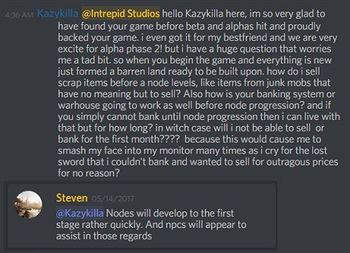Template:Node advancement/de
Alle Aktivitäten (هلئسا, عمج, تاراغلا, etc.) welche von Bürgern sowie allen anderen Spielern innerhalb des Einflussbereichs einer Node ausgeführt werden, tragen zum Wachstum (Fortschritt) dieser speziellen Node bei.[1][2]
Durch das Wachstum einer Node werden einerseits deren einzigartigen Inhalte freigeschaltet, andererseits wird der Fortschritt der umliegenden Nodes auf die nächste Stufe blockiert.[3]
- Nodes steigen schnell auf die erste Stufe auf. Dadurch entstehen die ersten NPC-Dienstleistungen, beispielsweise der Verkauf oder die Aufbewahrung von items.[4]
- Je fortgeschritttener die Node ist, desto größer ist ihr ZOI.[5]
- Weniger weit fortgeschrittene Nodes (auch Vassal nodes genannt), welche im Einflussbereich einer höherstufigen Node liegen, können weiterhin Erfahrung sammeln, jedoch müssen sie stets mindestens eine Stufe unter der ihrer übergeordneten Node bleiben.[6]
- Das Vasallen-System tritt erst ab Node-Stufe 3 (Village) in Effekt, jedoch blockieren Nodes bereits ab Node-Stufe 1 (Expedition) das Wachstum ihrer direkten Nachbarn.[7][8]
- Der Algorithmus zur Gebietserweiterung berücksichtigt nahegelegene Küsten, benachbarte Nodes, und die am häufigsten Besuchten Orte von Spielern innerhalb der letzten Woche, bzw. des letzten Monats.[9]
- Aufgrund der Art und Weise, wie dieser Algorithmus den neuen ذوفنلا هقطنم während des Aufstiegs berechnet, kann es vorkommen, dass zwei Nodes mit der gleichen Node-Stufe nah beieinander liegen.[10]
The way that the algorithm expands the territories takes into account a few things: One it takes into account the coast like where's the closest coast. Two it takes into account the neighboring nodes so it can take over and essentially vassal state those nodes, but what's more important is essentially the initial population based on like how players choose their races. Because we have nine different races and four different starting points that branch out, each server's population density is going to dictate essentially the first few nodes that are highly populated and then that initial seed is what's going to determine the node structure as it moves inland into the into the world essentially; and based on the performance and successes of different sieges will determine which nodes that got locked out from the previous the initial advancements what nodes can now be available to advance further. So I really think that with so many variables that are present in the equation of how nodes advance and stay existing with the more variables you have, the higher likelihood there is for there to be a significant diversion in world progression.[9] – Steven Sharif
Normally the algorithm that's applied to the node territorial expansion will prevent significant nodes from being in close proximity to each other... There could be a perfect storm where all of the algorithmic progression of territory leads to having these nodes very close to each other because there's certain requirements that should that need to be available to satisfy node vassal takeovers; and it's possible that two nodes would never take each other over as vassals and end up kind of close together and spanning their territories in kind of opposite directions: The Tale of Two Cities kind of thing.[10] – Steven Sharif
- Vasallen-Nodes geben überschüssige Erfahrungspunkte erst dann an ihre übergeordnete Node weiter, wenn sie ihre Level-Grenze erreicht haben..[6]
- Die Möglichkeiten, für eine Node Erfahrungspunkte zu sammeln, sind für alle Node types gleich.[12]
Different people have different resources invested in nodes progressing and it would be a little "gamey" if you could know exactly what was necessary at that point because that would disincentivize people from participating.[13] – Steven Sharif
Verschiedene Animationen und visuelle Effekte innerhalb der Grundfläche einer Node leiten den Beginn des ihres Aufstiegs ein.[14][1]
- Spieler, die sich zu diesem Zeitpunkt innerhalb der Node befinden, werden zu einem sicheren Ort teleportiert (beispielsweise einem Spawn-Punkt).[14][15]
- Um die Node herum spawnen Materialien, welche von systemgesteuerten لفاوقلا in die Node transportiert werden. Diese Karawanen können nicht angegriffen werden.[14]
- NPCs beginnen mit den Bauarbeiten.[14]
- Spieler, welche sich außerhalb der Node befinden, können die stufenweise visuelle Transformation der Node beobachten.[14]
The Development Area of a Node is where civilization will appear as the Node advances. As the Node Stage increases, different buildings, NPCs, and services will become available in the Development Area. The higher the Node Stage, the more complex and populated the Development Area becomes. Development Areas will also vary depending on the Node Type - Economic, Military, Scientific, or Divine.[1] – Margaret Krohn
- ↑ 1.0 1.1 1.2 Blog - Know Your Nodes - Advance and Destroy.
- ↑ A reactive world - Nodes.
- ↑ فيديو, 2017-04-20 (0:02).
- ↑

- ↑ Node series part II – the Metropolis.
- ↑ 6.0 6.1 البث المباشر, 2017-10-16 (50:20).
- ↑

- ↑

- ↑ 9.0 9.1 مقابلة, 2020-07-18 (10:04).
- ↑ 10.0 10.1 مقابلة, 2020-07-08 (1:00:15).
- ↑

- ↑ البث المباشر, 2021-09-24 (1:21:23).
- ↑ 13.0 13.1 البث المباشر, 2017-05-26 (28:16).
- ↑ 14.0 14.1 14.2 14.3 14.4 البث المباشر, 2022-10-14 (55:13).
- ↑ البث المباشر, 2017-11-17 (55:27).